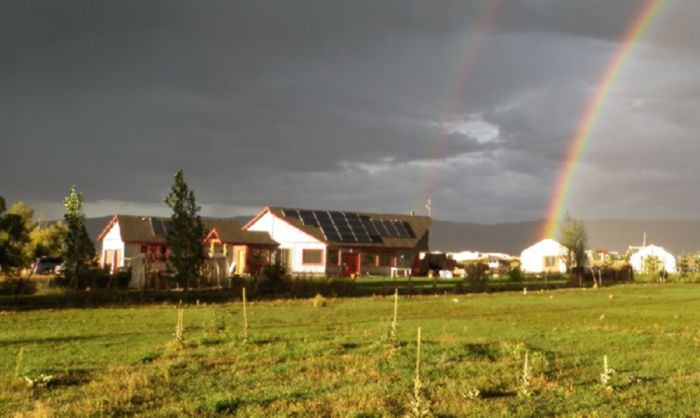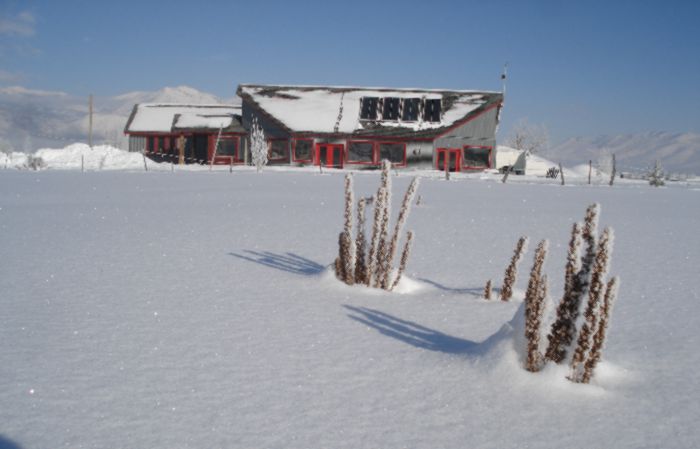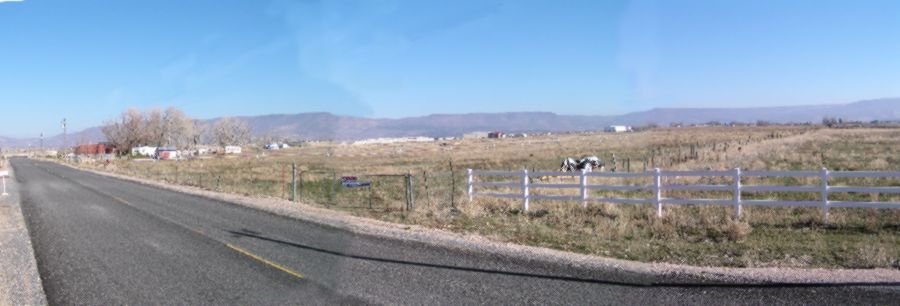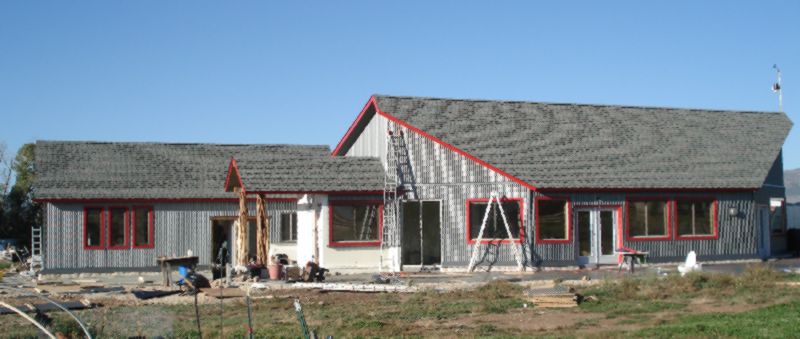



OUR ENERGY EFFICIENT HOUSE
HOW IS IT DOING
We have now been living in the house for four years and we are getting a pretty clear picture of what the house can do. The house hasn't dropped below 60 F degrees . That is without using any energy source other then the sun. Sixty degrees is a little cold in the mornings so we run the heater for a short time on cold mornings and we like to build fires in the wood stove in the evenings. We have been burning about 3/4 of a cord each year.
During the summer the hottest it got inside the house was about 76 degrees. It is always nice to come in out of the heat and sit in the cool house. October is the hottest month inside the house because the sun is low but outside temperatures are still in the 70's. We could open the doors and cool it off if we wanted, other wise we are just storing more heat for winter.
The solar hot water system provides more then enough hot water in the summer, too much as a matter of fact. I have to cover one heat collector panel so the system doesn't over heat. In the winter the tanks cool down to room temperature if we have several days without sun but most of the time the tanks have been between 95 and 160 degrees even when the outside temperatures are below zero. Between the wood stove and the solar hot water we use only about 100 gallons of propane for the year. We should be able to make our 500 gal. tank last for over 5 years.
We put 15 solar panels on the roof in 2009 and now seem to generate just slightly less electricity then we use each year. We are tied to the local power company and they are trading kilowatt for kilowatt. That puts our actual power bill for the year around $10.00. We have a small battery system that will run the essentials of the house; the well, freezer, frig. and a few lights. We use a clothes line in the summer but we do use our electric dryer in winter.

WHY DID I DECIDE TO BUILD IT?
In October of 2003 Jen and I took our two girls, Addison, 3 and Ria, 5 for a month of traveling around
I needed a place for my family to live that could keep us warm and comfortable using only the energy we could collect on our own and we needed to get it soon, before the crisis hit. I decided I wanted to build a house on a few acres of land so we could grow our own food. I wanted it within biking distance of a small town that had most of the necessities of life; grocery store, drug store, doctors, dentists, feed store and most of all a good community structure. I looked at all kinds of options all over the western
The reality was the


THE PAHS HOUSE SYSTEM
The PAHS system has several advantages: 1) It is very passive and simple, there are no moving parts, no electronics and it can work with no fuel other then the sun. 2) It keeps the house cool just as well as it keeps it warm. ( One of the problems with solar houses is they get too hot when the sun is shining.) 3) If the sun doesn't shine for several days or even weeks you don't have to resort to keeping warm with fossil fuels. The system collects the heat in the summer and stores months worth in the ground around it.
"Passive annual heat storage is a method of collecting heat in the summertime, by cooling the home naturally, storing it in the earth naturally, then, returning that heat to the home in the winter. It includes extensive use of natural heat flow methods, and the arrangement of building materials to direct heat from where ever we get it to where ever we want it, all without using machinery to make it work. With the rising cost of energy, all home builders should get familiar with basic PAHS principles."
The PAHS website
You can read more about PAHS at: http://www.earthshelters.com/Ch_1.html
My goal was not to build a "Green House", it was to build a house that was extremely energy efficient and would take little or nothing to maintain it. As the price of oil goes up the cost of things like paint and carpet will skyrocket right along with it. I started drawing plans for the house using the PAHS theory. It would be mostly covered in dirt with insulation over the dirt pile to isolate it from the outside air and water. It would have tubes bringing air conditioned by the warm dirt in and out of the house. After spending months working on this design I took it to the engineer and had him come up with the structural requirement. When I started pricing out materials it became apparent that the cost of a concrete and earth roof would be way more then we could afford. It was back to the drawing board. I redrew the house with a trust roof but with concrete walls on two sides of the house with dirt bermed to the top of the concrete.

OTHER FEATURES OF THE HOUSE
There are several other features to the house that make it more energy efficient some from the PAHS manual and some not. The house is a rectangle with the southeast and southwest corners cut off so those corners face the sunrise and sunset in winter. All but two of it's windows are on the south side. That way there is solar heating from sunup to sundown in the winter. In the summer the sun is too high in the sky to hit them directly so there is very little heat added to the house. The ceiling in the house is 9 feet high but the interior walls are only 8 feet tall. That allows air to be heated in front of the windows, then circulate throughout the house. It keeps the rooms in the back at the same temperature as the front. It also allows light to travel to all rooms in the house. We installed solar light tubes in all the back rooms so there is no need for electric lights during the day.
I spent a lot of time planning the electric lighting so that we could get the most light from the fewest light bulbs. The dinning room, kitchen, and living room are basically all one big room so if we turn on one light over the kitchen sink all three rooms are lit. There are lots of lights throughout the house but most lights have one switch per light bulb so you don't have to have 4 bulbs on when all you need is one. Nearly all our light fixtures are recycled lights that we collected used.
The house and the garage have south facing roofs that are at a 45 degree slope, the best average angle for the solar hot water panels and PV panels on the roof. In the attic I have a room with 440 gallons of water that is heated by the solar panels on the roof and is used for domestic hot water. Eventually I hope to use it to help keep the house extra warm by pumping it through tubes in the concrete floor.
INSULATION
The house has 2 to 8 inches of expanded polystyrene foam (EPS) extending out 20 feet horizontally away from the house. Any concrete that touches the outside air has at least 6 inches of EPS foam over it. By isolating the dirt under and around the house from the outside air and water it allows heat to collect in the dirt. When half the house is wrapped in 65 degree dirt, it keeps the house real warm.
The two sides of the house that are wood framed are 2x6 with blown in insulation, that gives it an R-23 value, then over the outside sheeting is a 2 inch layer of EPS foam that gives me an additional R-7.5. So my outside framed walls have an R-30+ value. In the attic we have Cellulose insulation with an R rating of 48. I wanted the exterior to be as maintenance free as possible. I debating many different materials and finally settled on corrugated metal with a powder paint coating. It will last the rest of my life time without needing paint and hopefully the rest of my kid's lifetime before needing replaced.
Many of our windows and most of the doors are recycled but they are high quality with low-E coatings. We are in the process of making window coverings that will insulate the windows and stop most of the heat loss at night. The front entry has a mud room and a second door that creates an air lock for stopping outside air from rushing into the house every time the door is open.
OUR FOSSIL FUEL USE
Our heater is mounted against the wall between the kitchen and the living room. You can't miss it when it comes on. The hot water heater is a tankless heater. When it comes on you can hear it from any facet in the house. My feeling is we need to know when we are using energy. I want it to be in my face. We have a 500 gallon propane tank out behind the house. It cost $720 to fill it. Psychologically I know I have just that much gas out there I have to make it last. Right now energy is not very expensive so most of us are just a little shocked when the bill comes but we can all pay it just fine. In a few years many of us will have to shut the heater off when we can no longer pay for the gas.
The reason I wanted a very passive and simple system was because as energy becomes more and more expensive and more and more scares it will be harder to keep high tech equipment operating.
THE PASSIVE ANNUAL HEAT STORAGE INFORMATION:Click Here
HOW TO BUILD YOUR OWN SOLAR HOT WATER SYSTEM:Click Here
![]()
![]() This Web Page Created with PageBreeze Free Website Builder
This Web Page Created with PageBreeze Free Website Builder ![]()
![]()